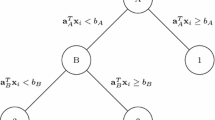Abstract
Combinational test pattern generation (TPG) is basically a search in a finite state space. In general, the search is performed in a branch-and-bound fashion. The branch-and-bound search builds a decision tree using two basic operations: decision making and backtracking. The size of the decision tree, and hence the efficiency of the branch-and-bound search, is directly dependent on the number of decisions made. This paper proposes a set of novel techniques for reducing the number of decisions and the size of the decision space. These techniques work directly on the maximum number of potential ways of justifying a given logical assignment. This maximum number is reduced by exploiting the properties of prime-and-irredundant covers. These same properties are also used to reduce the number of backtracks by implying a maximum number of necessary assignments. The reduction of the number of decisions and the identification of a maximum of necessary assignments make the proposed TPG method highly efficient as demonstrated by experimental results. This paper also proposes a novel combination of prime-and-irredundant cover extraction and transitive closure computation for a more efficient TPG process.
Similar content being viewed by others
References
P. Goel, “An Implicit Enumeration Algorithm to Generate Tests for Combinational Logic Circuits,” IEEE Trans. on Computers, Vol. C-30, No. 3, pp. 215–222, March 1981.
H. Fujiwara and T. Shimono, “On the Acceleration of Test Generation Algorithms,” IEEE Trans. on Computers, Vol. C-32, No. 12, pp. 1137–1144, Dec. 1983.
H. Cox and J. Rajski, “On Necessary and Non-conflicting Assignments in Algorithmic Test Pattern Generation,” IEEE Trans. on Computer-Aided Design, Vol. 13, No. 4, pp. 515–530, April 1994.
M. Abramovici, M.A. Breuer, and A.D. Friedman, Digital Systems Testing and Testable Design, IEEE Press, Piscataway, New Jersey, 1995.
S. Kundu, L.M. Huisman, I. Nair, V. Iyengar, and L.N. Reddy, “A Small Test Generator for Large Designs,” Proc. of the Int. Test Conf., Sept. 1992, pp. 30–40.
M. Teramoto, “A Method for Reducing the Search Space in Test Pattern Generation,” Proc. of the Int. Test Conf., Oct. 1993, pp. 429–435.
M.H. Schulz and E. Auth, “Improved Deterministic Test Pattern Generation with Applications to Redundancy Identification,” IEEE Trans. on Computer-Aided Design, Vol. 8, No. 7, pp. 811–816, July 1989.
F. Brglez and H. Fujiwara, “Neutral Netlist ofTen Combinational Benchmark Circuits and a Target Translator in FORTRAN,” Proc. of the Int. Symp. on Circuits and Systems, June 1985, pp. 663–698.
T. Larrabee, “Test Generation Using Boolean Satisfiability,” IEEE Trans. on Computer-Aided Design, Vol. 11, No. 1, pp. 4–15, Jan. 1992.
B. Aspvall, M. Plass, and R. Tarjan, “A Linear-Time Algorithm for Testing the Truth of Certain Quantified Boolean Formulas,” Information Processing Letters, Vol. 8, No. 3, pp. 121–123, March 1979.
S.T. Chakradhar, V.D. Agrawal, and S.G. Rothweiler, “A Transitive Closure Algorithm for Test Generation,” IEEE Trans. on Computer-Aided Design, Vol. 12, No. 7, pp. 1015–1028, July 1993.
W. Kunz and D.K. Pradhan, “Recursive Learning: A New Implication Technique for Efficient Solutions to CAD Problems,” IEEE Trans. on Computer-Aided Design, Vol. 13, No. 9, pp.1143–1158, Sept. 1994.
S.C. Seth and V.D. Agrawal, “A New Model for Computation of Probabilistic Testability in Combinational Circuits,” INTEGRATION, the VLSI Journal, Vol. 7, pp. 49–75, July 1989.
S.B. Akers, “Binary Decision Diagrams,” IEEE Trans. on Computers, Vol. C-27, No. 6, pp. 509–516, June 1978.
R.E. Bryant, “Graph Based Algorithms for Boolean Function Manipulation,” IEEE Trans. on Computers, Vol. C-35, No. 8, pp. 677–691, Aug. 1986.
S.B. Akers, “A Logic System for Fault Test Generation,” IEEE Trans. on Computers, Vol. C-25, No. 6, pp. 620–630, June 1976.
C.T. Ku and G.M. Masson, “The Boolean Difference and Multiple Fault Analysis,” IEEE Trans. on Computers, Vol. C-24, No. 1, pp. 62–71, Jan. 1975.
F.F. Sellers, M.Y. Hsiao, and L.W. Bearnson, “Analyzing Errors with the Boolean Difference,” IEEE Trans. on Computers, Vol. C-17, No. 7, pp. 676–683, July 1968.
R.K. Brayton, G. Hachtel, C. McMullen, and A.L. Sangiovanni-Vincentelli, Logic Minimization Algorithms for VLSI Synthesis, Kluwer Academic Publishers, Boston, 1984.
R.P. Jacobi and A.M Trullemans, “Generating Prime and Irredundant Covers for Binary Decision Diagrams,” Proc. of the European Design Automation Conf., March 1992, pp. 104–108.
S. Minato, “Fast Generation of Irredundant Sum-of-Products Forms from Binary Decision Diagrams,” Proc. of the Synthesis and Simulation Meeting and International Interchange. SASIMI'92/, 1992, pp. 64–73.
J.A. Waicukauski, E.B. Eichelberger, D.O. Forlenza, E. Lindbloom, and T. McCarthy, “Fast Simulation for Structured VLSI,” VLSI Systems Design, Vol. 6, No. 12, pp. 20–32, Dec. 1985.
H.B. Min and W.A. Rogers, “Search Strategy Switching: An Alternative to Increased Backtracking,” Proc. of the Int. Test Conf., Sept. 1989, pp. 803–811.
F. Brglez, D. Bryan, and K. Kozminski, “Combinational Profiles of Sequential Benchmark Circuits,” Proc. of the Int. Symp. on Circuits and Systems, May 1989, pp. 1929–1934.
Author information
Authors and Affiliations
Rights and permissions
About this article
Cite this article
Sahraoui, Z., Catthoor, F., Six, P. et al. Techniques for Reducing the Number of Decisions and Backtracks in Combinational Test Generation. Journal of Electronic Testing 12, 217–238 (1998). https://doi.org/10.1023/A:1008224716789
Issue Date:
DOI: https://doi.org/10.1023/A:1008224716789




